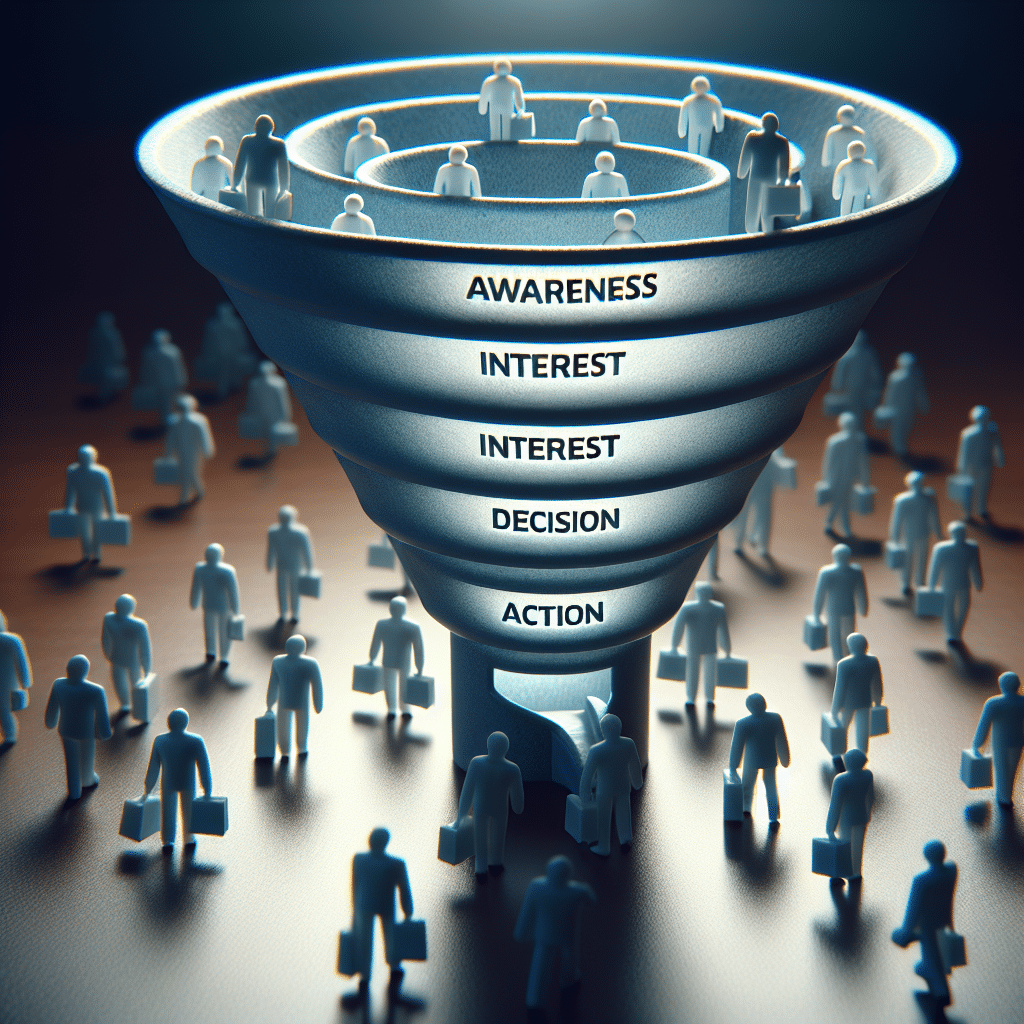Understanding Your Target Audience
Define Your Ideal Customer
To effectively build a sales funnel, you first need to know who you’re talking to. I always start by defining my ideal customer profile. Think about their demographics, interests, pain points, and buying behaviors. This gives you a solid foundation to tailor your marketing strategies directly to their needs.
Start by creating customer personas. I often create at least three personas to cover different segments of my audience. This allows me to refine my messaging and create targeted content that resonates with each group. Remember, the more specific you get, the better you can connect.
Once you’ve outlined your ideal customers, dig deep into their preferences. Are they active on social media? Do they prefer email marketing? Conduct surveys or look at analytics—this data will prove invaluable for the next steps in your funnel development.
Identify Problems and Solutions
Next up is understanding the problems your audience faces. Having worked with various clients, I realized that crafting solutions around their pain points is crucial. Start digging into common issues that your ideal customers experience and think of how your product or service can help.
For instance, frequently visiting forums or social media groups can give you insights into current discussions around challenges. You can then build your conversation around being the solution to those issues, and this will set you up perfectly for the next stage of your funnel.
Once you’ve got a grip on their problems, it’s essential to articulate how your offering addresses their needs. This forms the backbone of your funnel’s messaging and provides a powerful hook for capturing their interest.
Research Competitors
Don’t just focus on your own business; check out the competition. Scoping out others who are targeting similar audiences helps you see what’s working and what’s not. I find that keeping an eye on their marketing strategies provides a wealth of knowledge about audience preferences.
Take note of their sales funnels from start to finish. What content draws in customers? How do their emails look, and what are their calls to action like? You can borrow inspirations while still keeping your unique voice intact.
Finally, use tools like SEMrush or Ahrefs to analyze competitors’ keywords and traffic. This allows you to identify gaps in their strategies and position your funnel to fill those gaps, giving you a competitive advantage.
Creating Engaging Content
Craft Compelling Lead Magnets
When it comes to capturing leads, a killer lead magnet is your best friend. I love to create resources that provide genuine value to my audience. Whether it’s an eBook, a free trial, or a checklist, ensure that it offers something they can’t resist.
Think about what keeps your users awake at night. Develop lead magnets that address these specific issues. For example, if you’re in the fitness industry, a free meal plan could be exactly what your audience is looking for to get started on their fitness journey.
Once the lead magnet is ready, promote it across your channels. Give brief yet persuasive reasons to download it, and don’t forget to create a simple opt-in form to collect those precious email addresses!
Build a Valuable Email Sequence
Now that you have leads, it’s time to nurture them with value-rich emails. I usually create an automated email sequence that delivers helpful tips, insights, and case studies that relate back to my lead magnet.
Each email should take them closer to making a purchasing decision. I include stories or testimonials from satisfied clients to enhance credibility and build trust. Be personable—share snippets of your own journey if they’re relevant!
Most importantly, don’t push for a sale too soon. Focus on educating and building a connection, so when you do present your offer, it feels like a natural step in your relationship.
Leverage Social Proof
Nothing boosts confidence in your product quite like social proof. As someone who has seen the effects firsthand, I always recommend incorporating customer reviews, case studies, or testimonials into your content. This shows potential customers that you have a solid track record.
Make sure these testimonials are compelling and relatable. Highlight how your product helped real people overcome their challenges. When prospects see someone like them benefitting from your service, they’re much more likely to make a purchase!
Additionally, showcasing awards, certifications, or expert endorsements can add another layer of trust to your messaging. People want to feel secure in their purchasing decisions; social proof can significantly tip the scales in your favor!
Building Your Funnel Structure
Create a Clear Path to Purchase
A well-structured funnel guiding customers from awareness to purchase is vital. I recommend visualizing this process. Consider using flowcharts or diagrams to map out each stage. This can help clarify how prospects will interact with your brand from beginning to end.
Each stage of the trip should incorporate your target audience’s needs and actions. If someone downloads your lead magnet, what’s the next offer you want them to consider? Make the progression seamless and intuitive.
In my experience, maintaining clear calls to action throughout the funnel is crucial. Whether it’s a button to download a resource or an invitation to join a webinar, make it clear what the next step should be.
Want to turn your passion into income and earn while doing what you love?
Ditch the 9-to-5 grind! Our Internet Wealth Network Method shows you how:
✅ Earn in 30 days, doing what you love
✅Automate Passive Income Streams
✅ Get VIP support & Access to Exclusive Courses
Plus, get these bonuses:
🎁Facebook Marketing Unleashed
🎁Internet Marketing Secrets
🎁Social Media Revolution
🎁Video Marketing Mastery
Sign up below and get Free Internet Marketing Course ⬇️
Sign Up Here: InternetWealthNetwork.com/Info
Optimize for User Experience
User experience plays a huge role in whether or not someone completes the funnel. Slow loading pages or confusing navigation can derail even the best funnel strategies. I always recommend testing your site speed and usability regularly to ensure everything flows smoothly.
Make sure your website is mobile-friendly, too! With so many users browsing on their phones, having a responsive design is no longer a luxury; it’s a necessity. Simple improvements can significantly enhance the overall experience.
Gather feedback through user testing. Whether it’s friends, colleagues, or existing customers, getting real user insights can help you pinpoint any areas that need work.
Integrate Analytics for Continuous Improvement
Setting up analytics tools is not just a good idea—it’s essential. I love using Google Analytics to track user behavior through the funnel. By observing where users drop off or lose interest, I can adjust my tactics accordingly.
Utilize A/B testing to see what resonates more with your audience. Whether it’s email subject lines or different landing page formats, don’t be afraid to experiment and analyze results to refine your approach.
Lastly, continuously optimize your funnel based on the data you gather. Marketing is an ongoing process, so don’t think of your funnel as set in stone. Evolve it as you learn more about your audience and what drives them to convert.
Finalizing Your Offers
Create Irresistible Offers
Once your funnel is set, it’s time to finalize your offers. An effective sales funnel gives your audience clear reasons to make a purchase! I always consider what makes a great offer: it should solve problems effectively, be perceived as valuable, and create a sense of urgency.
Consider introducing limited-time promotions or bonuses to incentivize action. As an example, offering a discount or free consultation can spur decision-making—just make sure your audience knows it’s for a limited time!
I can’t stress enough the importance of clarity—make sure your offer is communicated clearly. Use straightforward language and highlight the primary benefits that resonate with your audience’s needs.
Communicate Clearly Between Sales and Marketing
A common hiccup in sales funnels is the disconnect between sales and marketing teams. I’ve seen how effective communication can drastically improve the overall experience. Everyone should be on the same page when it comes to leads’ status.
Utilize tools like CRM systems to maintain transparency. This way, all team members have real-time insights into the leads and can tailor their approaches based on past interactions, making the experience seamless for the customer.
Regular check-ins between teams to assess performance and share feedback can enhance collaborative efforts. Remember, both departments share the same goal: converting leads into loyal customers!
Measure Your Results
Finally, it’s crucial to measure the effectiveness of your sales funnel. Regularly analyze your metrics—like conversion rate, average order value, and customer acquisition cost—to see how well your funnel is performing.
If some stages aren’t converting well, dig into the data to identify bottlenecks and areas for improvement. I often revisit my strategies, making adjustments based on what the numbers tell me.
Tracking these metrics over time allows you to spot trends and learn what works for your audience. The better you understand your results, the more strategic you can be in refining your sales funnel.
FAQs
What is a sales funnel?
A sales funnel is a marketing concept that outlines the journey potential customers go through before making a purchase. It typically includes stages like awareness, interest, consideration, and ultimately, the purchase.
Why is understanding my target audience crucial?
Understanding your target audience is essential because it allows you to tailor your marketing messages, offers, and content to meet their specific needs and preferences, increasing the chances of conversion.
How can I create engaging content for my funnel?
Creating engaging content requires you to offer value while addressing your audience’s pain points. Use eye-catching visuals, compelling storytelling, and helpful resources like lead magnets to draw them in and keep them interested.
What metrics should I track in my sales funnel?
Key metrics to track include conversion rates, traffic sources, average order value, and customer acquisition costs. These metrics will help you evaluate the effectiveness of your funnel and identify areas for improvement.
How often should I update my sales funnel?
Regular updates are essential, ideally every few months or whenever you notice significant changes in your conversion metrics. Continuous improvement helps keep your funnel relevant and effective in reaching your audience.
Do You Want Passive Income While Enjoying The Freedom Lifestyle?
Look no further!
Inside The Internet Wealth Network Method, you’ll get:
✅ Grow Your Passions and Be Earning in 30 Days
✅ How To Automate Your Passive Income
✅ Free 24/7 Customer Support and Optional VIP Status
✅ We Teach You How To Start or Grow Your Email and SMS list
✅ Learn The Proper Way To Place Ads
✅ Free Courses To Give Away To Build your Automation
✅ Learn To Earn While Living The Motorcycle Lifestyle
✅ 100% No Questions Asked, Money Back Guarantee!
Plus…
🎁 Bonus #1: Facebook Marketing Unleashed
🎁 Bonus #2: Internet Marketing Secrets
🎁 Bonus #3: Social Media Marketing Revolution
🎁 Bonus #4: Video Marketing Mastery
No more struggling trying to figure out all this “Marketing Stuff”.
Whether You Are An Existing Business or Just Starting, This Is For YOU!
Sign up below and get Free Internet Marketing Course 🎁

Get started here: InternetWealthNetwork.com/Info



